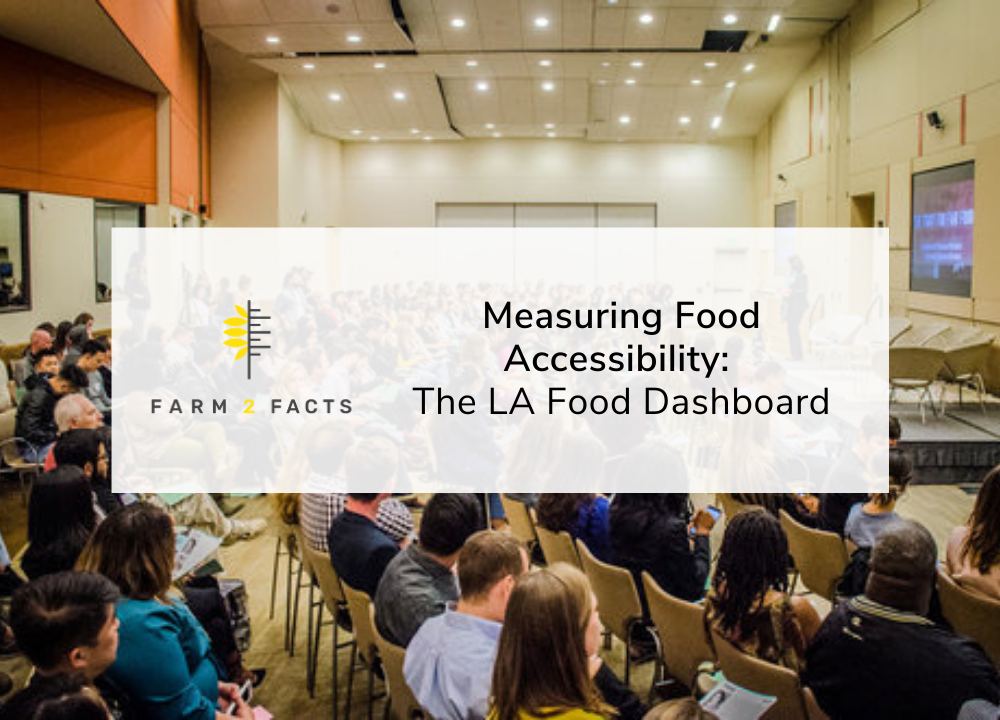
What is good food? How do we define what we want out of our food system, and how can you assess your farmers market, neighborhood, and city’s success at providing “good food”?
The LA Food Policy Council has developed an innovative way of answering and presenting these questions. Their program is meant to inform, not only governmental policy makers, but all of the community builders like you and us who care about local food.
The LA Food Policy Council created the Food System Dashboard in 2013 to assess how the Los Angeles was doing both locally and regionally. The most recent update to the dashboard in 2020 was conducted by our very own Chloe Green, who was instrumental in creating the Farm 2 Facts you know today. Comprised of over 250 indicators, the Dashboard reports detailed quantitative and qualitative data. The report is not a collection of impersonal market statistics, but rather a holistic narrative about the social dimensions of the food system.
Although the Dashboard was created specifically for LA, we believe that some of their key findings are being reflected nation-wide. The Dashboard defines good food as satisfying four broad conditions: healthy, affordable, sustainable, and fair. Here are their assessments of how LA meets each one of these goals:
Healthy
Good food requires everyone to have access to healthy food, particularly fresh produce. Though the price of fruits and vegetables has gone down, consumption has also fallen. This finding hints at the growing awareness in food culture that accessibility is not only about price. Other factors like transportation and availability at the market may be barriers to attaining healthy food.
Furthermore, fast food consumption and obesity rates are increasing across income levels and racial groups. This is particularly accentuated in South LA, a (poor) area saturated with fast food restaurants and with relatively fewer options for produce. Food inequity is often divided along racial lines, particularly with regard to Black communities.
Affordable
Food insecurity is decreasing overall. Thanks to multiple efforts at the county level, participation in CalFresh (aka SNAP or food stamps) has increased since 2013. We have shared this finding at Farm 2 Facts about farmers markets. Increased usage of SNAP is less related to the scope of the program than it is to awareness of the program. Even if people are eligible, they may not know they can use their SNAP benefits at the farmers market. However, when a concerted effort is made to increase awareness, we have observed SNAP usage as increasing by 800%!
Sustainable
The local food system is both a contributor to climate change and a key player in ending it. Overall, the Dashboard reports that agricultural land in LA has been disappearing as it’s converted to urban areas. However, organic farms are on the rise in the LA Foodshed, which is a promising sign for sustainability goals. The number of women and minority-owned farms is also greatly increasing. As we have recognized with our metrics, the participation of women, ethnic minorities, and LGBT+ people is essential to creating an equitable food system. These groups also play a special role in sustainability, as their farms are proportionally more likely to be organic.
Fair
In order to have good food, we must ensure fairness for food workers and animals. The LA Food Policy Council reports mixed results: food systems jobs are increasing, and wages for these workers are steadily rising. However, these wages have not caught up to the simultaneously rising living wages in LA. The gap between minimum wage and living wage for a small family in LA is $16.91.
A key player in the fight for LA food employee equity is the LA Street Vendor Coalition (LASVC). Street vendors, residents, and community organizations banded together to protect the rights of street vendors. They are a prime example of how successfully policy development require the centering of those who are impacted. Rudy Espinoza of Inclusive Action says,
“Street vending is an important industry because it cuts across many sectors. Street vendors not only activate our streets, they support local businesses, hire local workers, and often serve as the sole source of retail food in under-invested neighborhoods. For many of us in the campaign, street vendors represent an important sector of our economy, that while neglected, remains an important bedrock of local business eco-systems.”
It is here that we should note how farmers markets can be empowered to meet these four goals of healthy, affordable, sustainable, and fair food. Farmers markets are flexible, scalable food centers which can readily adapt to the needs of their communities. For areas where fresh produce is not available due to lack of brick-and-mortar grocery stores, street vending can be a key solution to providing food equity.
To find out how to support your farmers market in achieving these goals, visit Farm 2 Facts.
